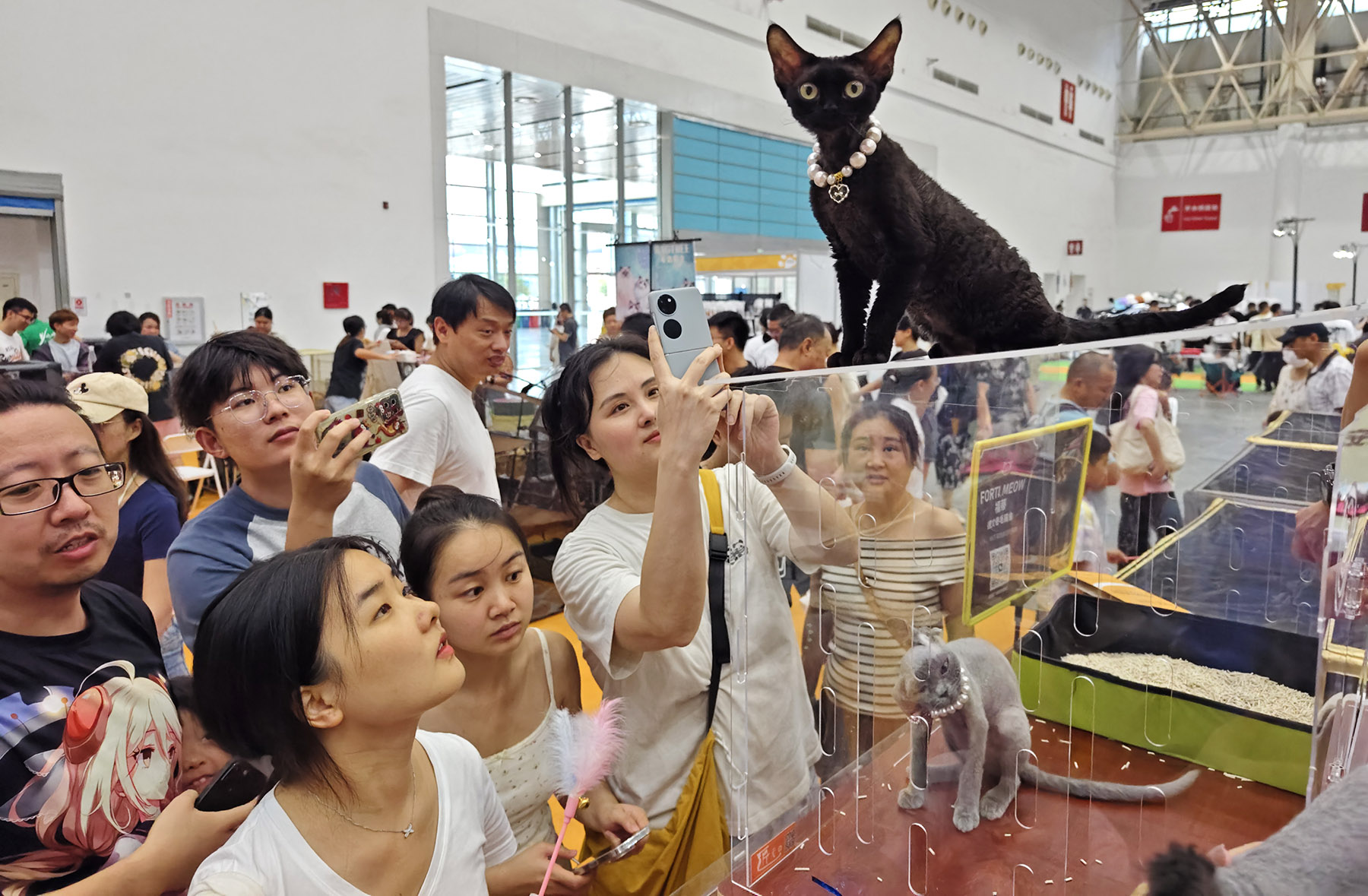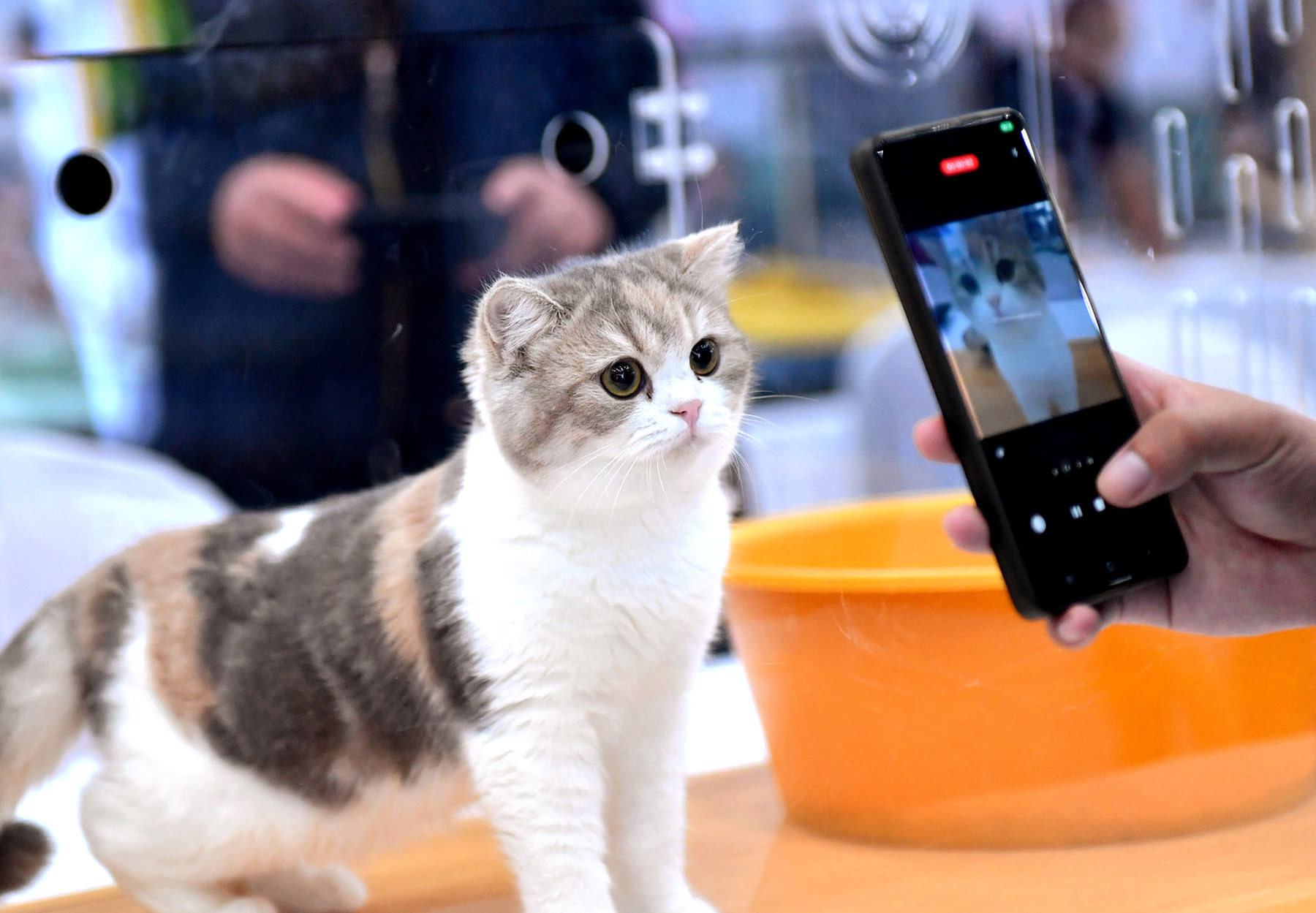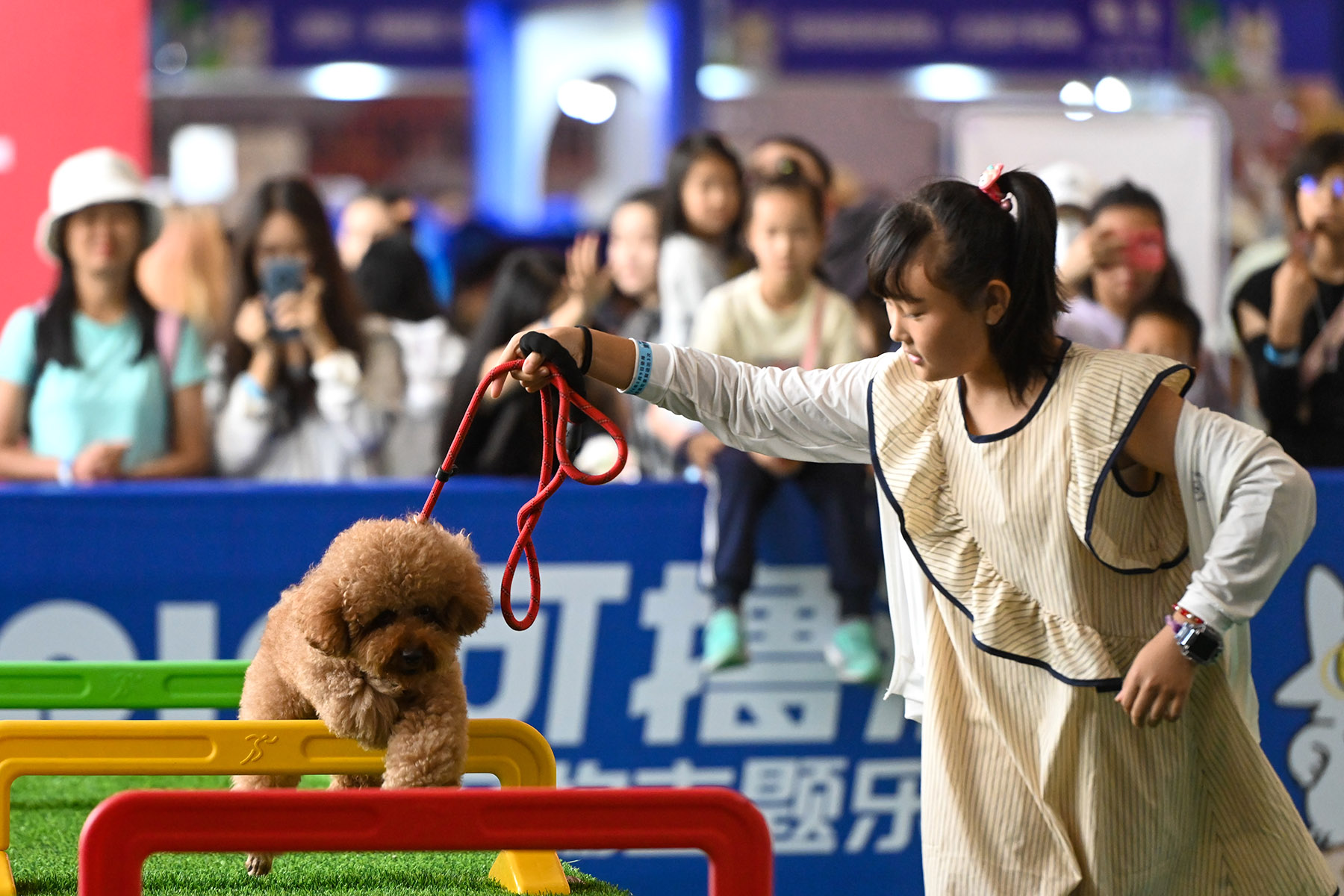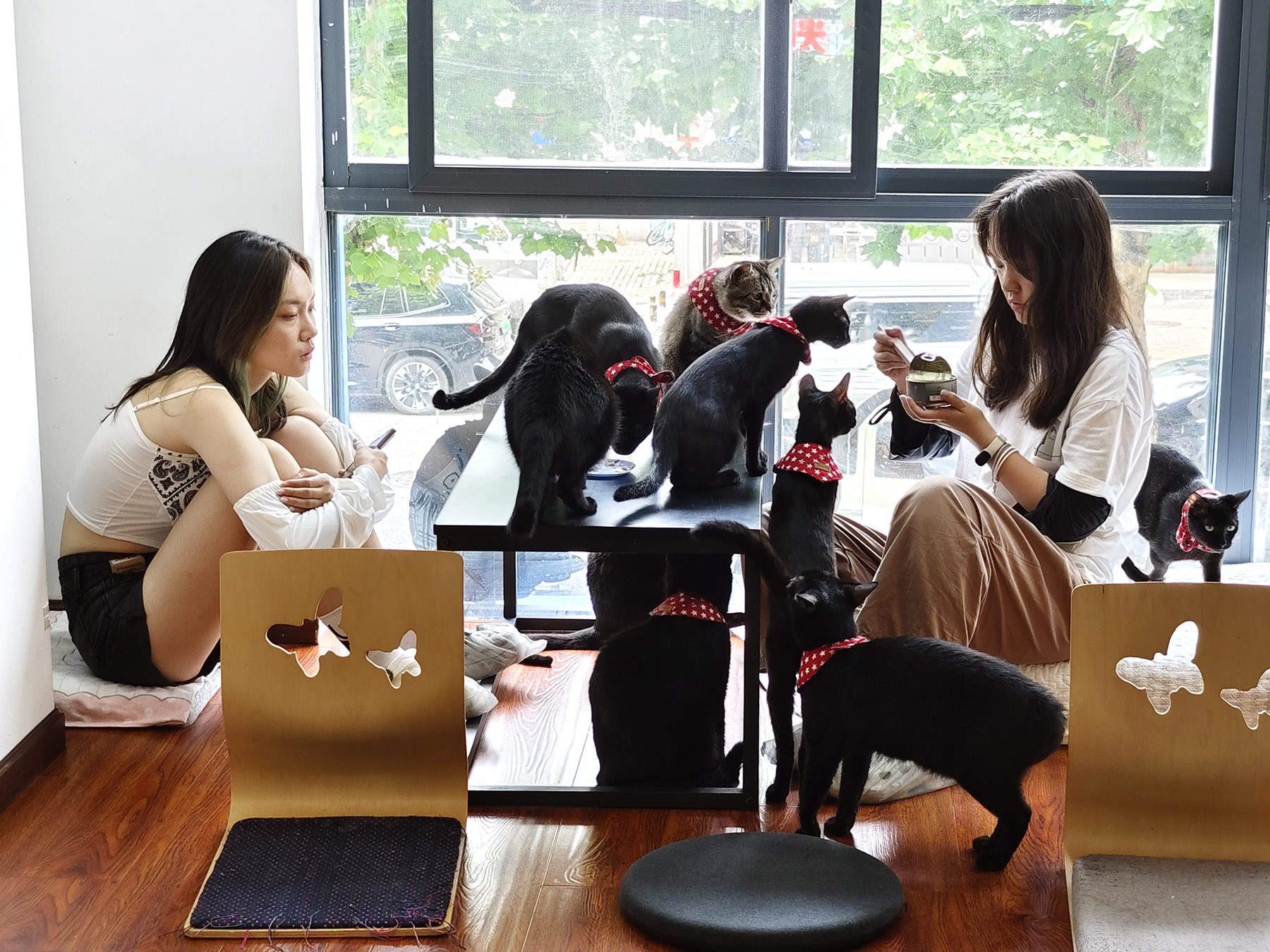Cat and dog cafes lead booming specialty services sector driven by rise in responsible ownership

With the pet population soaring and the pet economy flourishing in China, a wave of pet cafes has surged across the country, offering popular retreats where visitors can unwind while mingling with adorable animals.
There are over 3,500 cat cafe-related companies and more than 200 dog cafe-related businesses in the country, data from Qichacha, a leading platform offering company information inquiry services, showed.
Kwak Nakyung, a 24-year-old international student from the Republic of Korea, visits a stray cat cafe in Beijing twice a week with her friends. She is particularly drawn to a feline named Nainai.
“It is a quiet, clean, and healing space,” Kwak said. “I learned that many of the cats there are rescued strays, and it warms my heart to see them living better lives.”
She usually orders a cup of coffee and a dessert, while enjoying a relaxing afternoon with the cats.
The cafe she visits, Paw Infinity, has rescued nearly 30 stray cats since opening in June.
“We have seen a steady stream of customers,” said Ye Jian, the cafe’s owner. “Some come for the soothing presence of the cats, while others visit to donate food or adopt them.”
“All the cats here are vaccinated, and we ensure they are treated with respect. We share details of each cat’s personality with our guests, letting them know which ones enjoy being cuddled or fed.”
The cafe’s revenue directly supports the adoption and care of the cats, he added.

With the “adopt, don’t shop” philosophy gaining traction, such cafes are becoming a growing trend in China.
“It’s a mutual healing process that benefits both people and animals,” said Han Zihao, another Beijing cat cafe owner who has adopted over 60 stray or abandoned cats.
Unlike traditional stray animal rescue stations, which are often located in suburban areas and lack a stable income, stray animal cafes leverage commercialization to attract more visitors and generate steady revenue, Han said. This sustainable model helps ensure the long-term growth and stability of rescue efforts.
Dog cafes in China are also attracting growing interest, thanks to their energetic and lively atmosphere.
When Cheng Danni goes to work, her one-and-a-half-year-old golden retriever is sent to a nearby dog cafe in Hangzhou, Zhejiang province, where it has a “part-time job.”
“It is a vibrant place where my dog can get good care and make friends with other dogs. The dog does not feel lonely anymore,” said the 20-year-old, who had earlier discovered an advertisement seeking dog “staff” on Xiaohongshu, a Chinese lifestyle-sharing platform.
“This is actually a new type of foster care service that requires no payment from either side. The lovely dogs help attract more customers,” said Chen Yajie, owner of the dog cafe which has over 30 canine “staff members”.
The cafe offers customers a package that includes a 90-minute interactive experience with the dogs and a cup of coffee.

Each dog must pass an assessment before joining the cafe staff, which involves checking their vaccination records and deworming status, as well as assessing their temperament and social skills, Chen said.
“Rapid acceleration of urbanization has led to a faster pace of life and increased stress. Pet cafes provide close interaction with animals, helping address the growing need for spiritual comfort,” said Wu Yi, an associate professor at the College of Animal Science and Technology at China Agricultural University (CAU).
Wu noted that the boom in pet cafes reflects a growing acceptance and love for pets in Chinese society and highlights the thriving pet industry.
According to an industry report, the number of pet dogs in China reached 51.75 million in 2023, while pet cats numbered 69.8 million. The urban pet (dogs and cats) consumption market grew to 279.3 billion yuan ($39.29 billion) in 2023, up 3.2 percent from 2022, and is projected to climb to 361.3 billion yuan by 2026.
Wu also emphasized the need for sound standards and regulations concerning pet cafe sanitation and environments. Staff members must be well trained in terms of pet nutrition and behavior, as well as the handling of emergencies, to ensure animals receive proper care and treatment.
China’s pet economy has been thriving with the rise of responsible ownership and pet-friendly services.
In the 1990s, international pet brands began entering the Chinese market when domestic brands were virtually nonexistent. After the year 2000, the number of pets in China surged, with pet owners focusing more on emotional companionship rather than just keeping pets for home security. This shift fueled the rapid growth of China’s pet economy.
Seeing the potential of the emerging pet industry, Yan Jinsheng, a 47-year-old pet lover who hails from Tianjin and had previously worked in the automotive sector, shifted focus in 2013 to establish Favor Pets. Headquartered in Beijing’s Tongzhou district, the chain offers pet services and products, including retail stores, grooming, and training.
China’s pet economy is booming, with domestic brands selling pet food and a rapidly expanding variety of pet supplies and pet healthcare goods.

Pet owners today are increasingly aware of their responsibilities — such as vaccinating their pets and obtaining pet licenses, Yan said.
“It used to be costly and inconvenient to get a pet license, but now it’s much cheaper and easier, as you can apply at your local police station at a cost of only a few hundred yuan,” he explained.
The pet training sector in China is also gaining momentum.
There are currently over 28,000 companies in China whose names or scope of business include the hashtag “pet training”, with 6,559 new companies opening in 2023 alone, according to Qichacha, the business information platform.
In 2019, Yan launched the “pet kindergarten program,” an education initiative focused on teaching pets discipline and correct social behavior, while also helping pet owners to better understand the physical behaviors and signals exhibited by their furry friends.
“Pet owners need education on proper care, while pets require social adaptation training to correct undesirable behavior,” said Li Yabin, a dog handler at Favor Pets.
“This helps people and pets coexist harmoniously.”
Rising awareness of responsible ownership has made Chinese society more accepting of pets, with an increasing number of shopping malls, hotels, and parks becoming pet-friendly.
Wu, from CAU, pointed out that creating a harmonious environment where people and pets can coexist requires collective efforts from society.
In addition to regulating the responsibilities of pet owners and strengthening pet training, it is essential to promote pet friendliness through media and the internet, as well as to advocate for better laws and regulations to safeguard the safety and interests of the public, she added.

Shen Jing is a perfect example of the modern pet industry’s target customer. At 23, the human resources worker devotes nearly a fifth of her monthly salary to pampering her golden retriever.
“I spend around 1,500 yuan each month on everything from dog food and snacks to regular grooming sessions,” Shen said as she walked her dog in Suzhou, Jiangsu province. “He’s like a child to me.”
She is far from alone in her spending habits in China these days.
The growth of the middle class, rapid urbanization, and shifting demographics — including an aging population and a growing number of people who are choosing to delay marriage and parenthood — have transformed China’s pet market into one of the fastest-growing in the world.
This surge in demand bodes well for pet food and pet product companies, and for businesses ranging from dog grooming salons to luxury pet hotels.
He Yang, who manages the Pupurazzi pet chain brand in Chengdu said: “The pet market in China has enormous potential, and consumer demand is becoming increasingly diverse. This requires us, as industry professionals, to continually innovate”.
After opening on June 1, Pupurazzi, the largest flagship pet store in Sichuan, saw its revenue hit 2.5 million yuan in its first month, with 2,000 to 5,000 visitors daily. “This far exceeded our expectations,” He said.
Statistics show that the Chinese mainland pet healthcare market grew to approximately 70 billion yuan in 2023, accounting for roughly 24 percent of the overall pet industry.
Royal Canin, a France-based pet health and nutrition company, sees China’s pet economy as more than a passing trend. Xu Juan, general manager of Royal Canin China, said that the surge in pet-related industries is a sign of social progress — one that could become a new driver for economic growth.
Xu’s view is shared by Zhang Sining, a researcher at the Liaoning Academy of Social Sciences who noted that as modern society becomes more fast-paced and work-related pressures intensify, many people are turning to pets to fulfill their emotional needs.
“This trend is opening up a blue ocean of opportunities across various sectors of the pet industry,” Zhang said.


